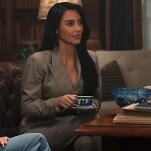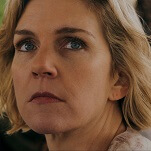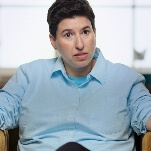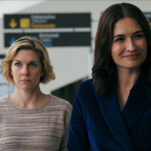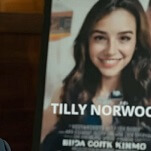Strip-mining nostalgia: The A.V. Club looks to yesterday for the potential franchises of tomorrow

Summer 2011 was the season of sequels and reboots, with roughly a third of the major releases following up a film or TV show, adapting a book or comic, or reviving a dormant franchise. So in our 2011 Summer Film Preview, we suggested Hollywood was thinking small and should make every 2011 film into a series installment or a series launch. And guess what? The summer of sequels took off, doing such big box-office business that it came reasonably close to rescuing a previously dire year for the film industry. So clearly our film preview was thinking too small. Franchises are vastly lucrative, and Hollywood shouldn’t just be looking to milk them out of existing films, it should be trying to make absolutely everything that’s existed in the past into a franchise of some sort. With Peter Berg’s Battleship on the way, other games from Ouija to Monsterpocalypse already optioned in response, it already feels like that’s happening. But why stop there? Everything was once somebody’s favorite thing, after all. So here are some of our suggestions for the inevitable future, as Hollywood continues to scrabble for recognizable shows, books, and household items to make into movies. (Speaking of which, how about a Scrabble feature film, huh?)
Franchise opportunity: Shirt Tales
What is it? An ’80s cartoon series inspired by a set of Hallmark cards, featuring a team of cute animals in T-shirts traveling around the world in a flying car/boat, solving half-assed mysteries, Scooby-Doo style.
Potential franchise problems: The idea of cutesy groups of mismatched animals running around has been done a million times, and Hollywood hates repetition and worn-out—ha ha! Just kidding! There’s no problem with this franchise at all. It’s yet another ’80s nostalgia item that could feature obnoxious CGI characters interacting with modern live-action stars, in the vein of Transformers with fewer explosions, or The Smurfs with more T-shirt tie-ins.
Elements to keep: The relentless merchandising. Also, the Shirt Tales’ shirts randomly flash little phrases reflecting whatever they’re thinking; CGI technology would make that fairly easy to do in a thoroughly annoying fashion.
Elements to discard: The orangutan with Humphrey Bogart’s voice is pretty dated. Perhaps instead he could be voiced by a more modern tough-guy type, like Samuel L. Jackson, or The Rock.
What will the franchise look like? Much like The Smurfs or Alvin And The Chipmunks, the first Shirt Tales movie will just involve the characters irritating and then helping some game comedian who really wants a paycheck. In Shirt Tales 2: Shirty Sexy Money, the now-smug-and-successful characters travel to New York City to broker a merchandising deal for their shirts, but ultimately realize they were happier and emotionally healthier back in their little country hometown. And in Shirt Tales: Scared Shirtless, their abruptly introduced old enemy Pantsmeister steals their magic T-shirts, prompting a high-flying round-the-world adventure mostly shot on a Vancouver soundstage.
Franchise opportunity: Gummi Bears
What is it? The Gummi Bears’ origins as delicious candy can be traced back, like the Nazis and the music of Kurt Weill, to 1920s Germany. But there’s much more to the bears than delicious treats born of tumultuous times. As viewers of Disney’s Adventures Of The Gummi Bears know, they also have adventures. And as the last survivors of the exiled Gummi civilization, how could they not have adventures?
Potential franchise problems: Over six seasons, the animated series built a rich mythology involving magic, Gummiberry juice, dragons, and swordplay. Probably too rich, really. They’re Gummi Bears, after all, not hobbits. Also, the Disney Gummi Bears never seemed particularly gummi.
Elements to keep: The Gummi Bears.
Elements to discard: All that other nonsense. The Gummi Bears revival should strip the Gummi franchise down to its core elements: bears and gumminess.
What will the franchise look like? The films should aim low. Teletubbies low. Gummi Bears: The Motion Picture will simply be 85 minutes of bears floating against a colorful background as they squish into and bounce off one another in slow motion, to the accompaniment of soothing ambient music. It will be a tremendous hit both at kid-friendly matinees at and midnight screenings near college campuses.
Franchise opportunity: Mad Libs
What is it? A popular parlor game in which a straightforward narrative becomes a lively, surrealist artwork, often through liberal addition of the words “butt” and “fart.”
Potential franchise problems: “Parlor games” are as alien a concept to modern generations as parlors themselves. Also, in these contentious times, “Mad Libs” sounds like a group of particularly peevish left-wingers, which could be a turnoff.
Elements to keep: The butts and farts, obviously. Also, the illusion of creativity.
Elements to discard: Anything to do with actual writing.
What will the franchise look like? In the tradition of films such as Liar Liar or Bedtime Stories, a smooth-talking businessman has his world turned upside down when he awakes to discover his speech transformed into gibberish by the random verbs, nouns, and adjectives being scribbled by his mischievous, often-neglected kid. After reconciling and learning to speak from the heart, he runs for public office in Mad Libs 2: Blank Vote, whereupon his affliction returns until he learns to set aside empty partisan rhetoric and deliver some good old fashioned straight talk. And in Mad Libs 3: Blank Out, the same ancient mystical curse that is revealed as the cause of the first two films’ shenanigans turns the whole world into a modern-day Tower Of Babel. Only the now-adult son from the original Mad Libs—the sole person who remains strangely immune—can reverse it. He does so with the help of either friendly aliens or God, depending on which studio is producing.
Franchise opportunity: Tinkertoys
What is it? A construction toy children can use to create anything they can imagine, so long as it can be assembled by inserting sticks into spools.
Potential franchise problems: A lack of narrative or even recognizable characters, if this were being made in any year before the likes of Battleship. Today, the most pressing problem would likely be getting it up and running before the Lego movie steals its thunder.
Elements to keep: The architecture angle, as people love stories about sexy, wealthy architects. Also, the brightly colored sticks, as audiences love pretty colors.
Elements to discard: The iconic metal can, which can be mentioned only in a passing, self-referential quip.
What will the franchise look like? A headstrong architect who is equal parts Willy Wonka and The Fountainhead’s Howard Roark upsets the establishment—and especially an evil, Donald Trump-like real-estate developer—with his insistence on erecting wacky buildings made entirely of rods, spools, and randomly placed flags. In Tinkertoys 2: Still Tinkering, he branches out into designing Tinkertoy-based cars and planes, with his newfound corporate success going to his head and eventually leading to a careless (though still appropriate for children) disaster that forces him to revisit his humble beginnings and reclaim his soul. And in Tinkertoys 3: Deep Tinker, the reclusive mastermind of what has become a wholly Tinkertoy world is called out of retirement to embark on a grand outer-space adventure, assisting in the construction of a new Tinkertoy space station that aims to peer into the center of the universe to see how life began. He discovers that all existence is actually made out of Tinkertoys, a fact revealed to him by… again, either friendly aliens or God, depending on which studio is producing.
Franchise opportunity: Gobots
What is it? An ’80s line of toys that originated in Japan, featuring robots that turn into cars, motorcycles, tanks, and other vehicles. Sound familiar? Of course not. It was a wholly original product.
Potential franchise problems: Gobots were always overshadowed by their more popular, not-at-all-similar robot-toy competition. That dynamic continues today, with Hollywood already having made several recent blockbusters about kiddie-friendly hardware from the ’80s with transformative powers. But is this really a problem, or an opportunity? Surely there’s an audience out there who chose the Betamax of robot toys back when they were kids.
Elements to keep: Definitely the whole “robots turn into some other shit” thing. That’s very commercial.
Elements to discard: It might be good to come up with better names for the Gobots. Instead of calling the tank simply “Tank,” how about something like, we don’t know, “Tankatron,” or “Optimus Tank”?
What will the franchise look like? First off, we should definitely plan on a trilogy, because the epic tale of the heroic Guardians battling the villainous Renegades simply can’t be told in one film. All those Gobots fan boys out there would call it a miscarriage of justice. The first film will have to be at least two and a half hours long, and will involve a thorough setup of the whole Guardians-vs.-Renegades mythology. In Gobots: Return Of The Defeated, the Renegades will gain the upper hand on the Guardians, but fans won’t mind, because the Guardians will suddenly be sassier and more racist. They’ll redeem themselves in Gobots: Shine Like The Sun, which culminates with the unlikely (but adorable) marriage of Guardian Gobots Cy-Kill and Spay-C.
Franchise opportunity: Strawberry Shortcake
What is it? Originally created as a greeting-card character, Strawberry Shortcake is a little girl who embodies the essence of strawberries and lives in Strawberryland with her friends, all based around fruits and desserts, and fights the evil “Purple Pie Man.”
Potential franchise problems: Aside from the fact that all of the characters are based around produce and desserts (Blueberry Muffin, Raspberry Tart, Plum Puddin’), Hollywood is all about big-tent, four-quadrant movies, and this seems like the opposite of that. Where’s the stuff that’s going to appeal to the menfolk? You can only coast so far on grown women with serious nostalgia for shitty ’80s cartoons.
Elements to keep: The basic idea of a bunch of specially powered women fighting a dark, evil man fits nicely within Hollywood’s current ideas of “feminism,” and the concept of a world based entirely on dessert could be appropriately psychedelic on screen.
Elements to discard: If we’re gonna get guys to this thing, we can’t have anything to remind them of the grudging responsibilities of adulthood. So Strawberry Shortcake’s baby friends are going to have to go.
What will the franchise look like? Remember Sucker Punch? Consider this the dessert course. In fact, let’s just set Zack Snyder and company loose on the whole mythos. Strawberry—clad in string bikini and stripper heels—will battle the giant, shadowy Purple Pie Man in a desolate landscape full of withered fruit trees and moldy desserts, hoping to regain the soul of Strawberryland and clear the dark clouds covering the face of her god and benefactor, Mr. Sun. She’ll be accompanied by appropriately buxom young women in similar attire, all color-coded to match the type of fruit they’re meant to embody. Trusty steed Maple Stirrup will now be a red-eyed wolf, pulling the redesigned, 25-percent-more-bitchin’ Oatsmobile.
Franchise opportunity: The Berenstain Bears
What is it: A set of children’s books by authors Stan and Jan Berenstain, following a nuclear family of four anthropomorphic bears who live in a gigantic tree and learn valuable life lessons.
Potential franchise problems: After decades of teaching valuable lessons, the Bears have since taken a right turn over the years into bluntly religious territory with titles like God Loves You! and The Berenstain Bears Say Their Prayers, particularly after Stan and Jan’s son Mike Berenstain took over the family business. Also, after Yogi Bear and The Country Bears, we have to wonder about the financial viability of any animated bears not named Pooh.
Elements to keep: The broad supporting cast. The residents of Bear Country have grown in number over the years, thanks to dozens of books and a trio of television incarnations, resembling a more family-friendly Springfield. The licensing possibilities are endless, as are the endless fan bases devoted to these characters. It’s a short trip from a few appearances to a Mayor Horace J. Honeypot fanfic website.
Elements to discard: The aforementioned religion-heavy storylines. Besides alienating viewers, the religious storylines offer far less opportunity for the broad, fart-based humor that would surely infect the series. Where’s the fun in Jesus?
What will the franchise look like? With so many books available—and short ones at that—it’s easy to incorporate each book into a more overarching, sweeping story. The Berenstain Bears would introduce the family and several main characters who all have to come together to prevent an evil, greedy land developer who tries to buy out the residents of Bear Country and bulldoze their houses. The Berenstain Bears 2: Bears In The Big City sends the country-dwelling Bears on an adventure to Bear York City. The possibilities of hilarious cultural clashes and misunderstandings are endless. Of course, things take a turn for the dramatic with the darker-tinged The Berenstain Bears 3: Saving Sister, in which, after falling in with the wrong crowd, Sister Bear has to battle a dangerous drinking problem after having her heart broken by school bully Too-Tall Grizzly. After this movie surely flops, be prepared for a return to a more lighthearted The Berenstain Bears: Bears In Space, which completely ignores the events of the third movie and accidentally sends Brother Bear to space, in a simultaneous rip-off of the 1986 film Space Camp and an attempt to spin Brother Bear off into his own franchise.
[pagebreak]
Franchise opportunity: Choose Your Own Adventure
What is it? A games/books series that was wildly popular among young-adult readers in the ’80s. They combined the limited narrative branching of some of the early text-based computer games with the portability of a paperback.
Potential franchise problems: The interactivity is an issue. Enterprising movie producers have tried the “Let the audience decide what happens” gimmick a few times over the years, and it’s never been a success. Plus, a truly interactive Choose Your Own Adventure movie would potentially leave the audience feeling ripped off if they ended up getting eaten by a shark or falling into a volcano within five minutes of the opening credits.
Elements to keep: Why not embrace the challenge? Go ahead and make the Choose Your Own Adventure movies interactive, and let the audiences do what the books’ readers have always done: keep going back to each decision point in the story and following it through until every possibility has been exhausted.
Elements to discard: Telling the stories in second person could be a little tricky, unless the producers want to make every installment look like Lady In The Lake.
What will the franchise look like? If you think it should be a glossy blockbuster about a magical wizard (think Jim Carrey) who leads a group of adorable preteens on a series of eclectic adventures, line up for theater one. If you think it should just be words projected on a big screen, line up for theater two.
Franchise opportunity: Little People/The Weebles
What is it? In the 1950s, Fisher-Price introduced peg-shaped characters to their toy trucks and playsets, and over the years have added more detail to their “Little People,” even giving the characters names and personality traits in a series of stop-motion animated videos that came bundled with the toys in the ’00s. In 1971, Hasbro came up with their own limited-articulation character line, the Weebles, with weighted roly-poly bottoms that allowed them to wobble, but prevented them from falling down.
Potential franchise problems: Feetlessness.
Elements to keep: No big-screen version of Little People will be deemed acceptable without the inclusion of the video series’ Aaron Neville-sung theme song:
Elements to discard: The Weebles have gone through multiple variations over the past four decades, but any respectable Weebles movie would have to stick to the original, egg-shaped design, and lose the freaky animal-like Weebles that have popped up over the past few years.
What will the franchise look like? There’s always the risk that if a Little People movie gets green-lit, some studio will rush a Weebles movie into production to compete. So here’s a radical idea: Weebles Vs. Little People. It’d be like Alien Vs. Predator, only with less bloodletting and more standing around.
Franchise opportunity: Tetris
What is it? A puzzle-like videogame developed by Alexey Pajitnov in the Soviet Union in the ’80s. It became an arcade favorite when it was released in the U.S., then exploded in popularity when it was bundled with Nintendo’s handheld Game Boy.
Potential franchise problems: Where’s the plot? Unlike some platform videogames that have clear heroes and villains, Tetris just has players stacking geometric shapes. The phrase “third-act problems” would apply here. So would “first-act problems.”
Elements to keep: Has 3-D technology advanced enough to reproduce that “still seeing falling blocks when you close your eyes” effect? Because that would be kinda cool.
Elements to discard: Even though Tetris wouldn’t be Tetris without Hirokazu Tanaka’s tinny rendition of the Russian folk song “Korobeiniki,” two solid hours of that crap would drive even Leo Tolstoy to drop the Peace and focus on the War.
What will the franchise look like? In the chill of the Cold War, one sad-sack Soviet citizen (think Paul Giamatti in a ushanka) spends bleak, endless days stacking irregularly shaped boxes in a Moscow factory, occasionally competing side by side with a comrade to see who can fill his quota fastest. Then one day, a long, straight box arrives on the factory floor, and everything changes…
Franchise opportunity: Sweet Pickles
What is it? Though now largely forgotten, the Sweet Pickles books and characters were once ubiquitous for kids growing up in the years after the series’ 1977 launch. Its 26 core books each starred an animal with a names keyed to a different letter of the alphabet; by the end of the stories, they each learned a valuable lesson. Sweet Pickles characters like “Yak” (the protagonist of Yakety Yak Yak Yak) and “Alligator” (from Who Stole Alligator’s Shoe?) could also be found on grooming products, board games, in cereal boxes, as a segment on Captain Kangaroo, and elsewhere. Then, after the series’ popularity peaked, they were frequently seen by Nickelodeon viewers, as the series was advertised into the early ’90s with an ad that suggested the Sweet Pickles characters would show up at your house in a green bus.
Potential franchise problems: The Sweet Pickles series always seemed like a triumph of marketing over quality. It was everywhere, but why? Illustrated by Richard Hefter and written by Hefter and Jacquelyn Reinach, the books featured characters and problems that seemed oversimplified even by children’s-book standards, plus a touchy-feely tone that made all their problems seem inconsequential. In a 1983 profile of the creators, People wrote “I’m OK—You’re OK has come to children’s literature.”
Elements to keep: Cute animals all living in a town together? That has potential!
Elements to discard: Um, everything else? Filled with unappealingly rendered characters like the depressive Dog and the vaguely terrifying Lion, Hefter’s illustrations look like they belong on the editorial page of a small-town newspaper or the side of an aging hippie’s van.
What will the franchise look like? Hopefully nothing like it used to. But beyond improving the art, perhaps future incarnations of the Sweet Pickles books could up the stakes a little by adding an element of mystery and terror, when the town of Sweet Pickles lands in the grips of an alphabet-obsessed serial killer. After Alligator, Bear, Camel, and Dog bite the dust, will Elephant be next? (Spoiler: Yes.)
Franchise opportunity: Titanic
What is it? Only one of the biggest hit movies of all time.
Potential franchise problems: The ship sinks, killing most of the characters.
Elements to keep: Oddly enough, the sinking ship.
Elements to discard: The stodgy old idea that sequels can’t return to the exact same setting and timeframe to tell multiple stories.
What will the franchise look like? It will look a lot like James Cameron’s original film, only it will feature entirely different characters experiencing the luxurious pleasures and subsequent terrors of a voyage on the Titanic. In Titanic 2: The Adventures Of Characters Who Aren’t Jack And Rose, we’ll see the romance of different characters from different social strata. Let’s just say the girl is the poor one this time. Yeah. That’s different enough. Then, in Titanic 3: The Unavoidably 3-D Installment, mismatched lovers will woo, panic, then drown in not one, not two, but three dimensions. (That’s assuming 3-D is still a thing when it gets made.) The twist: Did we already make the girl the poor one? Fine. Maybe this time, one of them’s a spy!
Franchise opportunity: The Decalogue
What is it? Created for Polish television, Krzysztof Kieslowski’s The Decalogue drew on the Ten Commandments for a series of 10 one-hour films illustrating how biblical instructions such as “Honor thy father and mother” and “Thou shalt not commit adultery” played out in a contemporary Polish setting.
Potential franchise problems: Kieslowski used up all the commandments the first time around.
Elements to keep: The numbers.
Elements to discard: The Ten Commandments, the Polish gloom, and the delicate dance between humanism and fatalism that characterizes Kieslowski’s work.
What will the franchise look like? Diverse! Consider this: Couldn’t any set of rules inspire future Decalogues? Assuming we ignore the requirement that a “Decalogue” have 10 rules, the possibilities are nearly endless: Decalogue 2: Bill Of Rights, Decalogue 3: The Magna Carta, Decalogue 4: Everything I Ever Needed To Know I Learned In Kindergarten, and of course, Decalogue 5: 8 Simple Rules For Dating My Teenage Daughter.
Franchise opportunity: Big Boy
What is it? A rotund, overalls-sporting character created to be the mascot of Bob Wian’s Big Boy restaurant chain. With his slicked-up hair, checkered wardrobe, and stout, burger-lifting arms, Big Boy has been the friendly face of Wian’s brainchild since the ’40s, when a 6-year-old named Richard Woodruff walked into what was then known as Bob’s Pantry, and Wian said, “Hello, big boy.” Woodruff later died at age 54 of an unspecified illness, though the fact that he’d ballooned to 300 pounds probably didn’t help.
Potential franchise problems: Two words: product placement. How are you going to convince McDonald’s to do a tie-in for a movie that’s essentially one long pitch for a competitor?
Elements to keep: Big Boy has appeared in special giveaway comics for decades, which means there’s plenty of material for screenwriters to tap. Start with the riddles and word-builder pages, and work backward.
Elements to discard: The special sauce. Seriously, that stuff is disgusting.
What will the franchise look like? We’re thinking a Tintin-esque motion-capture animated feature, perhaps involving Big Boy getting involved in a swashbuckling adventure in Belgium, where he’ll discover the deliciousness of frites.
Franchise opportunity: Operation
What is it? An electronic board game introduced in the ’60s that turned invasive surgery into a children’s pastime, Operation invited kids to open up patient “Cavity Sam” and systematically remove his body parts without activating an alarm and lighting up the red bulb in his nose. It’s like Malpractice: The Game.
Potential franchise problems: You mean aside from Operation being a board game without a story or characters? Ha! It isn’t like that stopped the makers of the upcoming would-be blockbuster Battleship. What’s important here is that there’s a faintly nostalgic hook on which to hang a wacky Disorderlies-style comedy.
Elements to keep: Cavity Sam is the only character in Operation, so he obviously stays.
Elements to discard: Operation is a bloodless game, but depicting all that surgery onscreen could get a little gory and push this film from PG-13 to the dreaded R. So the actual operations in Operation must go.
What will the franchise look like? In the first Operation, Cavity Sam is an important local developer who plans on razing the Operation hospital in order to build a parking lot. But after an unfortunate accident—Sam is electrocuted while talking on his omnipresent cell phone during his daughter’s big softball game—he gets shipped to the hospital and has his life saved by the ragtag staff. It goes without saying that he calls off construction of the parking lot, and learns to better balance work and family life. In Operation 2: Scrub Up! Sam is the hospital’s new administrator, and he cooks up a variety of get-rich-quick schemes—including entering portly male nurse Tiny in the city’s hot-dog-eating contest—to cover the premiums of uninsured patients. In Operation 3: Miami Beach, the Operation crew take their talents to South Beach, opening up a nursing home for some feisty (and horny) senior citizens.
Franchise opportunity: Zen And The Art Of Motorcycle Maintenance: An Inquiry Into Values
What is it? Robert Pirsig’s bestselling 1974 novel about one man’s search for philosophical balance and the meaning of Quality, set against the backdrop of a cross-country motorcycle trip with his son. Life-changing to some, clunky psychobabble to others, it nevertheless remains the most widely read work of modern philosophy—and a popular high-school graduation gift among families with hippie-ish parents.
Potential franchise problems: Most of the book is merely a series of essays exploring the author’s journey through schools of Eastern and Western thought. In other words: Too much Zen, not enough motorcycles.
Elements to keep: The connecting narrative of a father and his estranged son on a motorcycle trip and their need to reconnect; audiences love that stuff. Also the flashbacks to the father’s bout with insanity, his institutionalization, and the sensation of being pursued by a ghostly shadow figure known as “Phaedrus.” The franchise can make that into an actual ghost actually pursuing them on a motorcycle, sort of like Ghost Rider.
Elements to discard: All that philosophizing, except maybe during a tense interlude where the bike breaks down, and the father talks about the importance of knowing everything about fixing motorcycles, because you never know when you’ll be pursued by a vengeful ghost. The married couple, John and Sylvia, can here be re-imagined as a younger, sexier pair they briefly share a camp with, only to awake and discover that Phaedrus has dispatched them overnight. And definitely drop the downer of an afterword revealing that the actual Charlie was killed as a teenager, which could put a real damper on things.
What will the franchise look like? After Charlie learns (spoiler alert!) that his father and Phaedrus are one and the same at the end of the retitled, zippier Zen Motorcycle, his life is changed. We learn in Zen Motorcyle 2: Bloody Buddha that he’s inherited some of his father’s mental anxiety, which has begun manifesting itself as amnesia-inducing blackouts. Another cross-country trip with his friends turns deadly when they’re harassed by a motorcycle gang that doesn’t believe in taking care of their machines—and even worse, insist on a clear separation between objectivism and subjectivism—which causes Charlie to snap and assume the guise of Phaedrus. Charlie is, like his father, institutionalized for his crimes, which makes the reappearance of the ghostly figure all the more mysterious in the next film, Phaedrus: Quality Kill, which will officially launch a separate, only loosely connected horror franchise that can live on as long as the eternal stimulus of Quality causes man to create his world.
Franchise opportunity: The Wuzzles
What is it? One of the Disney company’s initial forays into animation for television, The Wuzzles is based around a land where everything is “two in one.” What does that mean in practical terms? Terrifying animal hybrid chimeras, that’s what, including lion-bumblebee, rhinoceros-monkey, and butterfly-bear.
Potential franchise problems: In typical ’80s cartoon fashion, the villain facing down the Wuzzles, a bipedal crocodile named Crock, is more of a bumbling oaf than a legitimate threat. And there’s little discussion of how the Land Of Wuz came to be so strange, with everything topsy-turvy and showers of fruit falling from the sky. If we’re going to suspend the audience’s disbelief, they’ll surely need to know more about how Wuz came to be. Plus, where are all the humans? Do we really think people are going to come to this movie to see the Wuzzles? No. They’re going to come to see Zac Efron hang out with Rhinokey and the gang.
Elements to keep: The characters themselves will offer plenty of opportunities for the world’s foremost special-effects technicians to work with, and the Land Of Wuz itself is a bright, colorful place full of silly sight gags, perfect for a kids’ film.
Elements to discard: Crock either has to go or has to be punched up.
What will the franchise look like? The Wuzzles In Disney Digital 3-D will still primarily be aimed at kids, but in order to also suck in their parents—who might just remember the show’s 13-episode TV run—the Land Of Wuz will have been given a complicated backstory and mythology, which will be debuted at Comic-Con and soon debated heavily on the Internet. In short, everything there will be the work of a twisted mad scientist, a Dr. Moreau just goofy enough to be kid-friendly. (We’re thinking slap some sunglasses and a silly wig on him, and have Hank Azaria play him.) Dr. Crock unleashed his creations on the world to take it over, but they instead became peaceful, happy, and fun-loving. Now he longs to reprogram them. With the help of their new friend Cody (Efron), can the Wuzzles save their beloved home and psychological well-being in time?
Franchise opportunity: Up With People
What is it? Hordes of chipper, singing children are sent out into the world to perform good works, put on a show, and spread the surface-level values of good old-fashioned American democracy. Also, lots and lots of smiling.
Potential franchise problems: In a word: positivity. Nobody wants to see a movie about people who are “up” in these despairing times. If you want to have an ending where the kids clean out the barn and put on a show, you’ve gotta earn those moments, and Up With People just doesn’t seem to understand this. Also, the 2009 documentary Smile ’Til It Hurts alleges that the group is creepily cult-like, what with arranged marriages and bans on sex and all, and that the founders created the group to spread radical right-wing politics. Everybody knows radical right-wing politics and bans on sex don’t sell! (Though arranged marriages might.)
Elements to keep: Singing and dancing! If Glee has proved anything, it’s that kids and teenagers love watching other kids and teenagers sing and dance. And we’ll keep just enough of the group’s Christian conservatism to try to sell the movie to the megachurch audience without turning anybody off.
Elements to discard: Do they have to smile all of the time? And we could do without the charity work and/or the focus on the bad things in the world today. Nobody wants to see that!
What will the franchise look like? Up With People: The Movie—rated PG-13—follows Sarah-Sue Carter, a sweetly unassuming girl from Pumpkin Corners, Alabama who just wants to sing and dance. But it’s 2011, and the recession is raging on, and her father has just lost his job as an executive dog groomer, which people will really relate to because the Hollywood executives’ executive dog groomer down on Sunset just lost his job last week, and wasn’t that sad? Still, her father always taught her that there’s anything can be fixed with a positive attitude and a song in her heart, and when the big tour bus rolls up in the Pumpkin Corners town square and singing, dancing teenagers start to spill out, she knows what she has to do. Along the way, she’ll learn all about sharing the song in her heart, lose her virginity, and hear the word “fuck” at least once to secure the PG-13 rating.
Franchise opportunity: Sylvia Plath’s The Bell Jar
What is it? A 1963 novel, famously based on Plath’s real experiences and acquaintances. It tells the story of Esther Greenwood, a young woman who travels to New York for a magazine internship, but descends into crippling anxiety, suicidal depression, and eventual hospitalization.
Potential franchise problems: The suicide stuff might be considered a downer, especially considering Plath’s real-life suicide shortly after the book’s publication. Also, bell jars aren’t particularly marketable as kids’ toys or fast-food giveaways, so spin-off merchandising might be a challenge.
Elements to keep: The New York setting is always a hit in movies. So is the idea of a young lady in the publishing industry, and characters based on real people. The Bell Jar practically already has its remake in The Devil Wears Prada.
Elements to discard: Like almost all book-to-film adaptations, this one should lose the author’s voice as much as possible. “Dark, harrowing, vivid, and intensely personal” won’t appeal to kids or seniors, though with enough of an emo spin, teenagers might like it.
What will the franchise look like? The Bell Jar 2: The Door Is A Jar gives Esther a spunky black girlfriend, a spunky gay male friend, and a spunky orphan child-companion to advise her on her problems; ultimately, they all start a popular advice column together. In The Bell Jar 3: Jarred And Feathered, Esther decides to lighten her mood by traveling across Europe, where in a series of wacky hijinks, she’s mistaken for a wealthy heiress and swept off to be married on a vast French estate, which somehow fails to comfort her, particularly when her terrible mother tracks her down just before the “I do.” And The Bell Jar 4: Bell Of The Ball reunites Esther and her would-be fiancé from BJ2; when Esther finally writers her novel and embarks on a book tour, they run into each other in a Manhattan hot spot, but she loses her memory after an accidental electrocution, and he has to remind her who she is and why being Esther isn’t all bad.
GET A.V.CLUB RIGHT IN YOUR INBOX
Pop culture obsessives writing for the pop culture obsessed.




